Composition of the German state parliaments
 |
|---|
|
Germany's federal system comprises 16 state parliaments (the German terms are: Landtag in large states, Bürgerschaft in Bremen and Hamburg, Abgeordnetenhaus in Berlin), each including directly elected representatives.
Parties in each parliament[]

Composition of German states' governing coalitions
In the table below, the parties with shading form part of the state government whilst the parties in bold are the largest party in that legislature.
| State | Seats (Majority) |
CDU/CSU | SPD | GRÜNE | AfD | LINKE | FDP | Independent | Other | Legislative term | Last election | Next election |
|---|---|---|---|---|---|---|---|---|---|---|---|---|
| Baden-Württemberg | 154 (77) |
42 | 19 | 58 | 17 | - | 18 | - | - | 5 years | 2021 | 2026 |
| Bavaria | 205 (103) |
85 | 22 | 38 | 20 | - | 11 | 2 | FW 27 | 5 years | 2018 | 2023 |
| Berlin | 160 (81) |
30 | 36 | 32 | 13 | 24 | 12 | - | - | 5 years | 2021 | 2026 |
| Brandenburg | 88 (45) |
15 | 25 | 10 | 23 | 10 | - | - | BVB/FW 5 | 5 years | 2019 | 2024 |
| Bremen | 84 (43) |
24 | 23 | 16 | - | 10 | 5 | 5 | BIW 1 | 4 years | 2019 | 2023 |
| Hamburg | 123 (62) |
15 | 54 | 33 | 7 | 13 | 1 | - | - | 5 years | 2020 | 2025 |
| Hesse | 137 (69) |
40 | 29 | 29 | 18 | 9 | 11 | 1 | - | 5 years | 2018 | 2023 |
| Mecklenburg-Vorpommern | 79 (40) |
12 | 34 | 5 | 14 | 9 | 5 | - | - | 5 years | 2021 | 2026 |
| Lower Saxony | 137 (69) |
50 | 54 | 12 | 9 | - | 11 | 1 | - | 5 years | 2017 | 2022 |
| North Rhine-Westphalia | 199 (100) |
72 | 69 | 14 | 13 | - | 28 | - | B 3 | 5 years | 2017 | 2022 |
| Rhineland-Palatinate | 101 (51) |
31 | 39 | 10 | 9 | - | 6 | - | FW 6 | 5 years | 2021 | 2026 |
| Saarland | 51 (26) |
24 | 17 | - | 3 | 6 | - | 1 | - | 5 years | 2017 | 2022 |
| Saxony | 119 (60) |
45 | 10 | 12 | 38 | 14 | - | - | - | 5 years | 2019 | 2024 |
| Saxony-Anhalt | 97 (49) |
40 | 9 | 6 | 23 | 12 | 7 | - | - | 5 years | 2021 | 2026 |
| Schleswig-Holstein | 73 (37) |
25 | 21 | 10 | 4 | - | 9 | 1 | SSW 3 | 5 years | 2017 | 2022 |
| Thuringia | 90 (46) |
21 | 8 | 5 | 22 | 29 | 5 | - | - | 5 years | 2019 | 2024 |
| Total (%) |
1,877 (100) |
569 (30.31) |
465 (24.77) |
279 (14.86) |
240 (12.79) |
145 (7.73) |
117 (6.23) |
17 (0.91) |
47 (2.50) |
Diagrams[]
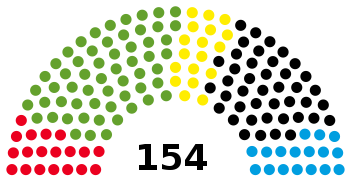
Baden-Württemberg

Bavaria

Berlin

Brandenburg

Bremen

Hamburg
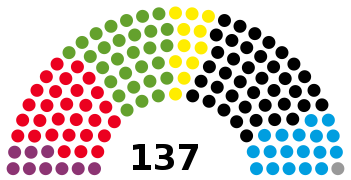
Hesse
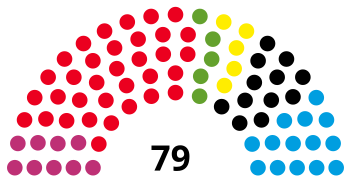
Mecklenburg-Vorpommern

Lower Saxony

North Rhine-Westphalia
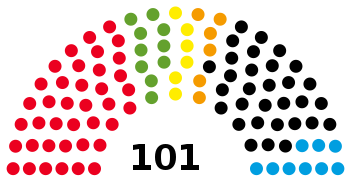
Rhineland-Palatinate

Saarland

Saxony
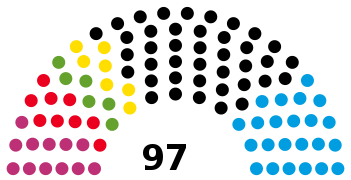
Saxony-Anhalt

Schleswig-Holstein
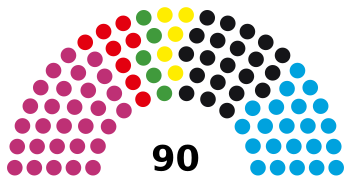
Thuringia
See also[]
References[]
Categories:
- Subdivisions of Germany
- State legislatures of Germany















